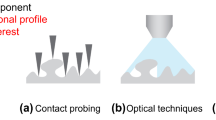Abstract
The process of capturing the shapes of objects through surface data sampling and generating a 3D CAD model is termed reverse engineering (RE) because the process is the reverse of the normal design and manufacturing sequence. The digitisation process can be achieved through spatial measurements taken by a coordinate measuring machine (CMM). The way of capturing data in a CMM can be divided into contact or non-contact methods. Diode-lasers or CCD cameras are commonly applied in non-contact measuring, while touch probes are applied in contact measuring. There are limitations in obtaining data for complex objects (for under-cut or inner structures) by means of the two abovementioned methods. Therefore, we have designed and assembled a novel device, called an abrasive computed tomography (ACT) apparatus, to overcome the abovementioned limitations.
The ACT apparatus uses an abrasive method to remove the inlaid object layer by layer and to capture the cross-sectional image of each layer with a CCD camera. A numerical scheme is applied to obtain the Bezier curve of the boundary in each layer. The combination of all cross-sectional boundaries is used to reconstruct the 3D CAD model of the object. The 3D CAD model can then be transmitted to generate the tool paths in a CNC machine or produce rapid prototyping in a RP machine.










Similar content being viewed by others
References
Varady T, Martin RR, Cox J (1997) Reverse engineering of geometric models-an introduction. Comp Aid Des 29(4):255–268
Yau HT (1997) Reverse engineering of engine intake ports by digitization and surface approximation. Int J Mach Tool Manufact 37(6):855–871
Motovalli S (1998) Review of reverse engineering approaches. Comp Indust Engin 35:25–28
Chan V, Bradley C, Vickers GW (1997) Automating laser scanning of 3-D surfaces for reverse engineering. SPIE 3204:156–164
Bradley C, Milroy M, Vickers GW (1994) Reverse engineering of quadric surfaces employing 3D laser scanning. In: Proceedings of the Institution of Mechanical Engineers, part B 208:21–28
Niem W, Wingbermuhle J (1997) Automatic reconstruction of 3D objects using a mobile monoscopic camera. In: Proceedings of the International Conference on Recent Advances in 3-D Digital and Modeling, Ottawa, Canada, 12–15 May 1997
El-Hakim SF, Pizzi N (1993) Multicamera vision-based approach to flexible feature measurement for inspection and reverse engineering. Opt Engin 32(9):2201–2215
Beraldin JA, Coumoyer L, Rioux M, Blais F, El-Hakim SF, Godin G (1997) Object model creation from multiple range images: acquisition, calibration, model building and verification. In: Proceedings of the International Conference on Recent Advances in 3-D Digital and Modeling, Ottawa, Canada, 12–15 May 1997
Soucy M, Godin G, Braibeau R, Blais F, Rioux M (1996) Sensors and algorithms for the construction of digital 3-D colour model of real object. In: Proceedings of the International Conference on Image Processing, Lausanne, Switzerland, 16–19 September 1996
Carbone V, Carocci M, Savio E, Sansoni G, De Chiffre L (2001) Combination of vision system and a coordinate measuring machine for the reverse engineering of freeform surfaces. Int J Adv Manufact Technol 17:263–171
Lee MY, Chang CC, Lin C-C (2002) 3D image reconstruction and rapid prototyping models improve defect evaluation, treatment planning, implant design, and surgeon accuracy. IEEE Engin Med Biol 21(2):38–44
Chang CC, Chiang HW (2002) Reconstruction of the CAD model of a complex object by abrasive computed tomography. In: Proceedings of the IEEE/ASME International Conference on Advanced Manufacturing Technologies and Education in the 21st Century, Chia-yi, Taiwan, 11–14 August 2002.
Calamia JR (1994) Advances in computer-aided design and computer-aided manufacture technology. Curr Opin Cosmet Dent 1994:67–73
Kai CC, Meng CS, Ching LS, Hoe EK, Fah LK (1998) Rapid prototyping assisted surgery planning. Int J Adv Manufact Technol 14:624–630
Altschuler BR, Toboada J, Segreto VA (1975) Intra-oral dental laser grid surface mapping. Appl Opt Instrum MedicIV SPIE 70:347–350
Author information
Authors and Affiliations
Corresponding author
Rights and permissions
About this article
Cite this article
Chang, C.C., Chiang, H.W. Three-dimensional image reconstructions of complex objects by an abrasive computed tomography apparatus. Int J Adv Manuf Technol 22, 708–712 (2003). https://doi.org/10.1007/s00170-003-1571-8
Received:
Accepted:
Published:
Issue Date:
DOI: https://doi.org/10.1007/s00170-003-1571-8




